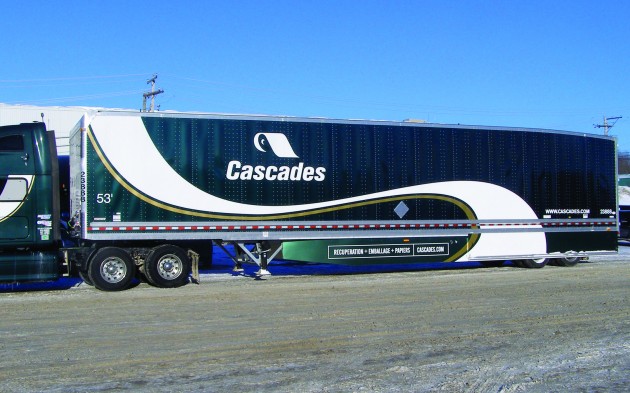In pursuit of a more efficient trailer
BLAINVILLE, Que. — Undeterred by the failure of its modified trailer to produce any fuel savings at the 2011 Energotest track trials in Blainville, Que., paper and packaging giant Cascades and trailer manufacturer Manac teamed up again in 2013 to build and road-test a second trailer.
After 10 months on the road and roughly 63,000 kilometres, fuel records suggest a 3% savings.
Since February 2014 Cascades has been making the 1,570-kilometre round-trip run between its home base in Kingsey Falls, Que. and Guelph, Ont. with this second, 53-foot wedge van. Looking at the box itself, the modifications are nearly identical to those made on the first van, which had a top front rail with a high-radius curve and six inches of slope along the rear 10 feet of the roof.
Why do an instant replay of the original modifications? After all, they yielded no fuel savings on the track. But this was troubling. The wind tunnel tests and computer simulations for the first trailer yielded a 12% reduction in drag. The researchers were confident that this would translate into fuel savings on the ground. 
Looking back at their substantial effort, the collaborators, which included FPInnovations and Laval University, identified some real problems and speculated about possible reasons why PIT, which runs the Energotests, recorded no fuel savings.
“We saw that we didn’t have the exact same design as we had for the wooden model for the wind tunnel. The curves were not right, because we used an old trailer. We learned that if you want a better test, order a new trailer, but put special spec’s on it,” says Alain Boutin, director of conformity and risk management, Cascades.
In a 2013 paper that PIT director Yves Provencher and PIT technical leader Marius-Dorin Surcel wrote on wind tunnel testing versus track trials, they suggested the wind tunnel tests for the trailer project may have had shortcomings; ie., the trailer scale model may have been too small and the wind effects in the wind tunnel may not have properly mimicked field conditions for trailers.
It is established truth that the SAE J1321 Fuel Consumption Test Procedure – Type II used on the track trials are unassailable. However, says Dany Veilleux, product manager, van, construction and forestry, Manac, “The track test is a small sample. We want to be (looking) for an improvement on a long test. We are confident that there is some improvement with the top rail.”
“There was no way we could get results with the tests, but radically different results on the track,” adds Tom Ramsden, vice-president sales and marketing, Manac.
In any case, Manac and Cascades felt the project deserved a second chance. The second time around, then, instead of modifying a used trailer, Manac built a new one from scratch in its St-George plant. This yielded a more accurate reproduction of the models on which the 2011 trailer modifications were based. Also, building the second trailer served as an early test of production line construction. “Now we have the extrusions, fewer parts, it is easier to manufacture and is lighter also,” Veilleux says.
Looking at the trailer as a whole – box, chassis, tires, etc. – there are some big differences between it and the trailer run in the 2011 Energotest trials: This is a two-axle trailer. (The first trailer had three axles). The pin is set at 61 inches, instead of the usual 48 inches that Cascades usually specifies. This sets the trailer closer to the tractor, reducing the gap and aerodynamic drag. It is also tricked out with side skirts and Hendrickson air bags that the driver can overinflate to raise the van floor flush to the dock.
Aware of the risk of an apples-to-bananas comparison, Cascades has been comparing the fuel records of the second trailer with those of an unmodified truck doing the same run. It has been carrying the same cargo weight and, except for the roof modifications, modified suspension and 255R7022.5 duals instead of super-singles, it is configured nearly the same way.
Whether this Macintosh-to-Cortland comparison unequivocally demonstrates that the reduced fuel consumption is because of the changes to the box alone is a headache for another day. “Probably the thing we have to do is put the trailer on the track, with skirt and singles,” Boutin suggests.
Heretical as it may be to even think it, perhaps that top rail curve and rear top drop are doing something that the SAE procedure does not reveal.
In any case, Manac and Cascades are learning, and moving in the direction that trailer design may be going in North America. “Cascades is always aware of new things on the market. If you have something new with promising results, we will be willing to try it,” Boutin says.
“At every step we learn something,” Veilleux says. “It is important to cross-verify designs by different means.” As well, Ramsden adds, “Work that is being done in the engineering environment can sometimes be considered slow and methodical, but at each step we are able to modify and fine-tune things and move to the next step.
Have your say
This is a moderated forum. Comments will no longer be published unless they are accompanied by a first and last name and a verifiable email address. (Today's Trucking will not publish or share the email address.) Profane language and content deemed to be libelous, racist, or threatening in nature will not be published under any circumstances.